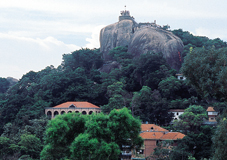
Tucked away in China's southeast coastal area, Xiamen, the second biggest city in Fujian Province, has a fitting nickname: "Garden on the Sea." Xiamen is surrounded by ocean on three sides, and faces Taiwan straight across. Between the azure sky and aqua sea with its long beaches are mountain villas hidden by green trees. It's no wonder the city has been called the "best residence in China."
Organic and Mystical
Jinmen Island faces Xiamen across the sea.
Exotic flowers, rock gardens and rare herbs cover the lush landscape of Xiamen. The Wanshi Botanical Garden in the southwest corner of the city consists of 20 sub-gardens and planting areas like Pine and China Fur Garden, Rose Garden, Palm Garden, Arbor, Introduced Variety Area, Medical Herb Garden, Large-scale Cactus Garden, and Orchid Nursery,
where 3,000 tropical and subtropical plants are nurtured. Lying at the foot of Five Old Men Hill, "Wulaofeng," is the South Putuo Temple, which enshrines Avalokitesvara, the Goddess of Mercy. A magnificent structure, the temple includes the Hall of Heavenly Kings, the Shrine of Sakyamuni Buddha, Hall of Great Mercy, and Tripitaka Pavilion, all hidden by lush trees and wreathed in incense smoke. Because the Bodhisattva is believed to answer prayers, the temple attracts a large number of visitors year round. On the 19th day of the second, sixth, and ninth lunar months, big celebrations are held when incense is burnt and obeisances made in prayers for health and fortune.
Hulishan Cannon Emplacement, built in the 19th century, is one of the many historical structures in the area.
Adjacent to the South Putuo Temple is Xiamen University, which combines Chinese and Western teaching principles.
Invested by the famous overseas Chinese Chen Jiageng (Tan Kah Kee), the university's beautiful campus is a great outdoor attraction. East of Xiamen University is the Around-island Ring Road, beginning and ending at Ferry Square, along which main tourist attractions can be found. This road is bordered by a five-kilometer beach on one side and beautiful mountain scenery on the other. Swimming is popular, and the nearby fishing villages of Zengcuo'an and Huangcuo allow visitors to witness and experience a typical fisherman's life.
Piano Islet
Street portrait drawing is one of the many aspects of Xiamen's artistic culture.
Gulangyu is a small island to the southwest of Xiamen, covering less than two square kilometers. The 600-meter-wide Egret River separates it from the main island, but a shuttle ferry is available every five minutes. The name Gulang, "drum waves," describes the drum-like sound produced by waves hitting crevices in the southwestern reefs. Aside from electromobiles, Gulangyu is free from all motor vehicles and is serenely peaceful. Gulangyu is also known as "Piano Islet," as there are a total of 600 pianos on the island. Its 70 ancient pianos collected from various countries over the past century make the Piano Museum a magnet for visitors.
This Roman style villa on Gulangyu Islet is one of the many styles of architecture to be seen here. Gulangyu is known as "World Architecture Museum."
Architecture on the islet varies greatly in style, giving it the epithet "World Architecture Museum." As from the mid-1900s, a total of 14 countries established consulates here in Xiamen Overseas Chinese built villas, and businesspeople and missionaries followed.
Sunlight Rock, Xiamen's main landmark, is 92.68 meters above sea level. The rock is 40 meters in diameter and is in the vicinity of the Lotus Flower Nunnery, Summer Resort Cave and Dragon Head Villa. Originally built in 1913, Shuzhuang Park beneath Sunlight Rock used to be the private villa of a merchant named Lin Erjia. The garden is on the sea, which is part of it. Activity and leisure contrast and complement each other here.
Delicious Xiamen Dishes
The picturesque South Putuo Temple enshrines a Bodhisattva, and draws many tourists.
Xiamen cuisine represents that of the whole of Fujian. It is one of the eight most famous Chinese cooking styles. In past years, Xiamen cuisine has diversified, forming a unique flavor that can be described as simultaneously mild, tasty, light, crisp and slightly spicy. It is particularly famous for seafood, herbal dishes, Putuo vegetable dishes and local snacks.
One of the most famous dishes has the poetic name "Half Moon Sinking in the River." When crescent-shaped dried mushrooms and fried gluten puff balls are placed into a round bowl, they look like a half moon and its reflection in the river. Nanputuo vegetable dishes are deliciously fresh and succulent, but not oily. Other Xiamen snacks include meat dumplings, peanut soup, leek dumplings, rice porridge with sea crab, and taro. The most famous old eateries are Wu Zaitian on Datong Road and Huang Zehe on Zhongshan Road. Gulangyu meat pie is the most famous local snack and is not to be missed.
With its seaside location, mystical gardens and world-renowned cuisine, the "Garden of the Sea" is a must-see trip in China.
(China Today October 20, 2003)
|

